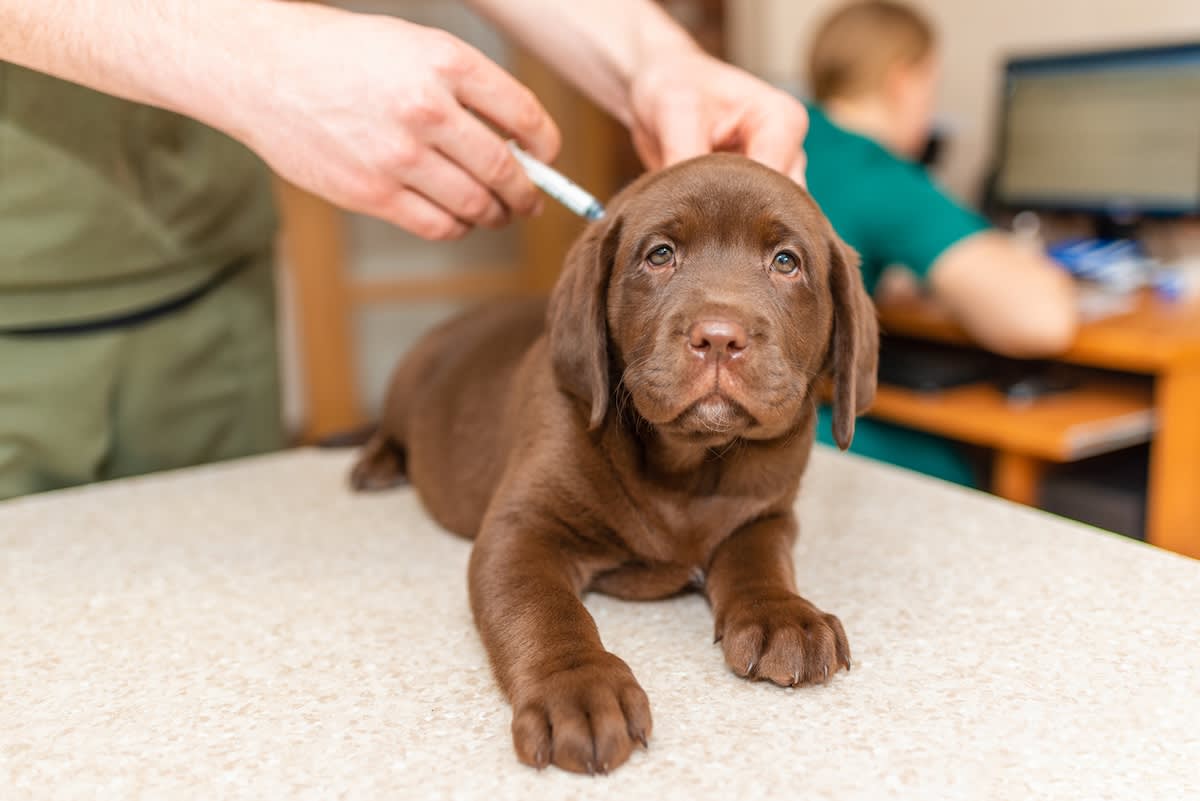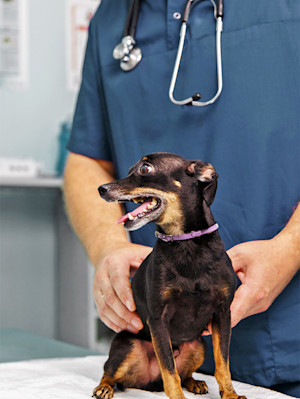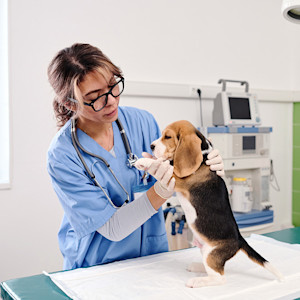Unsure About Vaccinations? The Cost of Treating the Diseases They Prevent
The difference in price is staggering
In this article:
What are vaccinations? UK dog vaccinations Vaccine safety Vaccination cost Diseases
There’s lots of things we drag our feet on; replying to Whatsapps, doing bank admin that involves a phone call, anything that involves a phone call tbh... If there’s one thing you can’t drop the ball on though, it’s your pet’s health. You (yes you!) are in charge of a living, breathing being who, without you, wouldn�’t be able to survive. No pressure.
Thankfully, the things you need to do to help keep your pup healthy have been heavily documented. One of the first – and most important – things to do when you bring your new pet home is to get your pet’s vaccinations up-to-date. Annoyingly, vaccinations aren’t often covered by insurance but that doesn’t mean you’re saving money if you skip them. The diseases the vaccinations prevent would cost you hundreds, (likely thousands) more than the vaccinations themselves. If you don’t get your dog the vaccinations they require up front, not only are you gambling with your bank balance, you’re also gambling with your dog’s health.
Still not convinced? Read on to find out which diseases vaccinations in the UK prevent, how these diseases affect your pet and how much you could end up paying out to treat them.
How much do you spend on your pet per year?
What are vaccinations?
Dogs, like humans, have an immune system designed to fight disease. For those of you for whom GCSE biology is a distant memory, think of the immune system as having two parts. The first forms the initial line of defence against any new infection entering the body. It performs reasonably well but has its limitations. The second part of the immune system is capable of defending much more effectively against specific diseases, but only after it has been exposed to them. It is learning on the job, if you like.
This is why, when dogs are exposed to an infection for a second time, they are often able to fight it off more quickly, sometimes without developing any symptoms at all. This works well until the body encounters a particularly dangerous or fast-acting disease that overwhelms the first line of defence before the second has had a chance to learn how to respond. These diseases are often fatal to your pet.
This is where vaccines come in. Vaccinations are a way of tricking the body into thinking it has been exposed to a disease, when in fact it has only encountered a modified version of the virus or bacteria, one that cannot cause severe illness. This gives the second part of the immune system the training it needs to defend the body quickly and effectively, should it ever come into contact with the real infection.
Vaccinations not only protect the individual animal, but also help safeguard the wider dog population. The more dogs that are vaccinated, the less the disease spreads, and the lower the chance of an unvaccinated dog being exposed to it.
Which vaccinations should my dog have in the UK?
In the UK, there are certain vaccinations that are considered ‘core’, meaning they are recommended for every dog. Non-core vaccinations are only advised for specific pets under particular circumstances.
Let’s take a closer look at the recommended vaccination schedule.
Core vaccines
There are four core diseases against which dogs in the UK should be vaccinated:
Canine Distemper Virus.
Canine Adenovirus (which causes infectious canine hepatitis).
Canine Parvovirus.
Non-core vaccines
Non-core vaccinations include:
Rabies: required if your pet travels abroad.
Kennel Cough: recommended for dogs that frequently mix with large groups of other dogs, such as in boarding kennels, on group dog walks or in doggy daycare.
While exact vaccination schedules can vary slightly between veterinary practices, current guidelines recommend the following:
Primary vaccinations
A primary course of vaccinations for puppies nursed by their mother includes:
First vaccination at eight weeks of age.
Second vaccination at 12 weeks of age.
These should cover:
Distemper, hepatitis (adenovirus) and parvovirus with a vaccine known as DHP.
Leptospirosis, with either L2, which protects against two strains of Leptospira bacteria, or L4, which protects against four strains. L4 is the most recommended vaccine in the UK. More on this later.
A third and sometimes a fourth vaccination may be advised at 16 and 20 weeks of age for distemper, hepatitis (adenovirus) and parvovirus (DHP). Not for leptospirosis.
Your vet will advise whether these additional doses are appropriate for your puppy.
Hand-reared puppies may require earlier vaccination, as they do not receive maternal antibodies. This should be discussed with your vet.
Boosters
Almost all adult dogs should receive a full booster of all four core vaccines at one year of age. After that, they should receive:
Leptospirosis boosters annually.
Boosters for distemper, parvovirus and adenovirus every three years.
There are exceptions to these recommendations. For example, dogs that are unwell, undergoing specific treatments or those that have previously experienced a severe allergic reaction to a vaccine. If you are unsure whether your dog should be vaccinated, speak to a trusted vet about your concerns.
Are vaccines safe?
The core vaccines available for dogs have been extensively tested for safety and are used globally, having been in widespread use for decades. Numerous studies show they are both effective in preventing disease and safe for your pet.
The likelihood of your dog having a reaction varies slightly between vaccines, but generally ranges from 16–45 reactions per 100,000 vaccinations. These reactions are rare, and most are mild and short lived, such as temporary swelling at the injection site, a slight fever or a reduced appetite.
In extremely rare cases, more serious side effects can occur, such as anaphylaxis or immune-mediated disease (a condition where the immune system mistakenly attacks its own body). However, the benefits of vaccination far outweigh these risks.
Cost of vaccinations
The cost of vaccinations varies across the country, but on average, a primary vaccination course for puppies costs around £70 in the north of England, compared to £140 in London. Annual boosters are around £50 in northern England and up to £95 in London.
For a dog who lives for 12 years (the average lifespan in the UK is 11.2 yearsopens in new tab), this works out at a lifetime cost of approximately £680 in northern England, and up to £1,280 for dogs based in London. Vaccinations are administered by a vet, and the cost should include an annual health check to ensure your pet is otherwise well and healthy. It is also a valuable opportunity to talk to your vet about any questions or concerns you may have regarding your pet.
Vaccinations are not usually covered by insurance, but many practices offer loyalty schemes to help with the cost. Importantly, if your pet is not vaccinated, their insurance may be invalidated.
Estimated lifetime cost of vaccinations for dogs range from £680–£1,280.
Core vaccination diseases
The diseases these vaccines protect against are highly contagious, cause severe illness and are often fatal.
1. Canine Distemper Virus
Vaccination against distemper should be given to puppies at eight and 12 weeks, with a third dose at 16 weeks to be considered. Boosters should then be given at one year of age and every three years thereafter. It forms the ‘D’ part of the combined DHP vaccine.
Distemper is a highly contagious disease caused by a virus. Symptoms include difficulty breathing, discharge from the eyes and nose, and coughing. Affected dogs stop eating and develop a fever. They often also show gastrointestinal and neurological symptoms, and may develop hard, thickened skin on the nose and footpads. Distemper is fatal in up to 80 percent of cases, particularly in younger dogs, even with treatment.
In the early 1900s, before the development of vaccines, distemper was one of the leading causes of death by infectious disease in dogs in the UK. Vaccine development began in the 1920s, with highly effective vaccines becoming routine for puppies by the 1980s. The distemper vaccine is considered highly protective. Thanks to vaccination, distemper is now rarely seen in the UK. Unfortunately, it still circulates in wildlife populations, so sources of infection remain. When pets do become infected, the mortality rate is still around 80 percent.
Because distemper is caused by a virus, treatment is supportive only. It will typically involve hospitalisation for fluids, respiratory support such as oxygen or ventilation, and intensive nursing care. Due to the severity of the disease, many cases are referred to specialist hospitals to give the best possible chance of survival, and even with intensive care there is sadly no guarantee of recovery.
Treatment costs usually range from £4,000–10,000.
2. Canine Adenovirus Type 1 (CAV-1) – Infectious Canine Hepatitis
Vaccination against adenovirus should be given to puppies at eight and 12 weeks, with a third dose at 16 weeks to be considered. Boosters should then be given at one year of age and every three years thereafter. It forms the ‘H’ part of the combined DHP vaccine.
CAV-1, also known as Infectious Canine Hepatitis, is a highly contagious viral disease. It causes fever, jaundice (yellowing of the gums and the whites of the eyes) and abnormal bleeding, which can be severe.
As with distemper, infectious canine hepatitis was widespread across the UK in the early 1900s and carried a high mortality rate of up to 90 percent, especially in puppies. The vaccine for this disease is considered 100 percent protective. Thanks to widespread vaccination, this disease is now extremely rare in the UK, however, like distemper, it is still around in wildlife populations, which can occasionally lead to cases in unvaccinated dogs.
There’s no cure for Infectious Canine Hepatitis, so treatment is supportive and intensive. Dogs typically require several days in isolation and may need blood transfusions due to the risk of severe bleeding. These cases are often referred to specialist hospitals, and the prognosis remains poor despite aggressive therapy.
Treatment costs usually range from £2,000–10,000.
3. Canine Parvovirus
Vaccination against parvovirus (the ‘P’ of DHP) should be given to puppies at eight and 12 weeks, with third and fourth doses at 16 and 20 weeks to be considered, particularly in black and tan breeds. Hand-reared puppies can be given this as a sole vaccination from four weeks of age. Boosters should be given at one year and then every three years. Parvovirus vaccine is available as a sole vaccine for high-risk puppies or as the ‘P’ part of the combined DHP vaccine.
Parvovirus is a serious viral disease that first emerged in the late 1970s and spread rapidly across canine populations worldwide. It causes severe vomiting and bloody diarrhoea and carries a high mortality rate of up to 80 percent, especially in unvaccinated puppies. Even with modern intensive care, mortality in unvaccinated dogs remains around 10-20 percent.
Although vaccination was developed quickly, outbreaks in unvaccinated dogs are still common in the UK. The virus is widespread in the environment and remains a significant threat. The vaccine is around 95 percent protective. In rare cases, vaccinated dogs may still become infected, but their symptoms are usually mild. Most cases of vaccine failure are due to insufficient or delayed vaccination during early life.
Treatment involves several days of hospitalisation, in isolation, and often includes antiviral medications and intensive supportive care. Referral to a specialist hospital may be needed, but even treatment in general practice can be costly.
Treatment costs usually range from £1,200–6,000.
4. Leptospirosis
Vaccination against leptospirosis should be given to puppies at 8 and 12 weeks of age. Boosters should be given at one year of age and then annually. The leptospirosis vaccine is available as a standalone vaccine or combined with parvovirus, distemper and adenovirus. There are two types:
L2, which provides protection against two serovars (types) of leptospira bacteria.
L4, which provides protection against four serovars.
L4 is now the recommended vaccine for most pets in the UK.
Leptospirosis is a bacterial disease spread through contact with infected urine. Rats are a common source, and infection usually occurs through contaminated water or soil. Leptospirosis can also be passed from infected dogs to humans. It primarily affects the liver and kidneys and can be fatal if left untreated.
Before the introduction of vaccines, leptospirosis was a common cause of infectious kidney injury in dogs. After the introduction of the L2 vaccine, case numbers dropped significantly. However, cases have been rising again in recent years. Although leptospirosis remains relatively uncommon, the increasing number of imported dogs from mainland Europe has brought in additional strains. The two additional serovars covered only by the L4 vaccine are now more frequently detected in the UK.
The L4 vaccine is safe, with only 45 reported adverse events per 100,000 doses. Most side effects are mild and short-lived. Serious side effects are very rare. The vaccine is effective in reducing the risk of infection, death and bacterial shedding, helping to protect both the vaccinated pet and others. However, its protection does not last much beyond a year, so annual boosters are important.
Unvaccinated dogs are at the highest risk of developing severe, and potentially fatal, infection. Infected dogs require three to five days of hospitalisation, typically in an isolation ward. Treatment consists of supportive care, including fluids and anti-sickness medications, as well as antibiotics. If caught early, survival rates are around 80 percent.
Treatment costs usually range from £2,000–5,000.
Vaccination costs: the bottom line
It is understandable that some owners may initially hesitate to vaccinate their pets due to concerns about cost, safety or a belief that their dog may not need it. However, choosing not to vaccinate your dog can have devastating consequences, both emotionally and financially. The diseases that core vaccines protect against are not only highly contagious and often fatal, but they can also lead to prolonged suffering for your pet and immense distress for you as an owner. Watching a much-loved dog battle a preventable illness is an experience no pet owner should have to endure.
Beyond the emotional toll, the financial burden can be significant. Treatment for conditions such as parvovirus, distemper or leptospirosis often involves days of hospitalisation, intensive care and specialist referral. These costs can run into thousands of pounds, with no guarantee of recovery. In contrast, vaccinations are safe, affordable and proven to provide reliable protection when given on schedule.
Vaccinating your dog is not just an act of routine healthcare, it is a vital step in protecting their life, your peace of mind and your household from the distress of avoidable disease.
References
“2024 Guidelines for the Vaccination of Dogs and Cats – Compiled by the Vaccination Guidelines Group (VGG) of the World Small Animal Veterinary Association (WSAVA)opens in new tab.” Journal of Small Animal Practice, Wiley-Blackwell, Apr. 2024, https://doi.org/10.1111/jsap.13718.
“Dog and Puppy Vaccinations | the Kennel Clubopens in new tab.” thekennelclub.org.uk.
Gardiner, A. “Early History of Canine Distemper.opens in new tab” Vet Times , 4 Mar. 2016.
Gore, Thomas C et al. “Three-year duration of immunity in dogs following vaccination against canine adenovirus type-1, canine parvovirus, and canine distemper virus.opens in new tab” Veterinary therapeutics : research in applied veterinary medicine vol. 6,1 (2005): 5-14.
Prittie, J. (2004), Canine parvoviral enteritis: a review of diagnosis, management, and prevention. Journal of Veterinary Emergency and Critical Care, 14: 167-176. https://doi.org/10.1111/j.1534-6935.2004.04020.xopens in new tab
“Parvovirus in Dogs and Puppiesopens in new tab.” pdsa.org.uk, Jan. 2023.
“Life Expectancy (Years).opens in new tab” RVC, 2022, www.rvc.ac.uk/Media/Default/VetCompass/Infograms/220422%20Life%20Tables.pdf.






